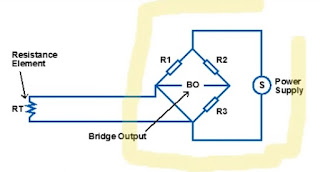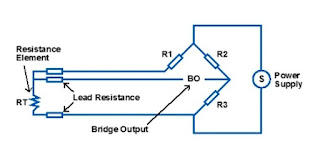RTD
Resistance Temperature detectors (RTDs) are sensors used to measure temperature.
Generally greater stability,accuracy and repeatability when compared to thermocouples.
Slowly becoming the proffered temperature measurement device in many industrial applications because of high accuracy and therefor suitability for precision applications.
How RTD works?
Most RTD elements are made from a length of fine coiled wire of a pure material,typically platinum,nickel or copper wrapped around a ceramic or glass core.
The material has a predictable change in resistance as the temperature changes.
RTD works by correlating the resistance of the element with temperature.The hotter metal becomes,the greater its resistance.
Platinum is typically used.
Advantages of platinum are
1.linear resistance vs Temperature
2.Chemically Inert
3.Stable over temperature
Unlike thermocouple RTD require a small amount of current
The resistance measured correlates to temperature
Lead resistance can contribute to measurement error,especially as wire length increases.
Differnet Types of RTD
Two -Wire
Only used when high accuracy is not required.
Resistance of connecting wires is added to that of the sensor,leading to measurement errors.
Three-Wire RTD
The two leads to the sensors are on adjoining arms.
There is a lead resistance each arm of the bridge so that the resistance is cancelled out as long as the two lead resistances are the same.
Four-Wire
Four-Wire is most accurate RTD temperature measurement setup
The device measures and removed the lead resistance in both sets of leads.
RTDs are also made from different materials
RTD can be made cheaply in Copper and Nickel but these have restricted ranges because of non-linearity and wire oxidation problems in the case of Copper.
Platinum is the preferred material for precision measurement because in its pure form Temperature coefficient of resistance is nearly linear;enough so that temperature measurement with precision +1 deg C or -1 deg C can be readily achieved with moderately priced device.
Advantages of RTD
1.Stable for long periods of time
2.Ease of recalibration
3.Accurate reading over relatively narrow temperature spans.
Disadvantages of RTD
1.Smaller overall temperature range
2.Higher Initial cost
3.Less rugged in high vibration environments
4.They requirement more complex measurement circuit
5.Self-Heating and lead errors when high accuracy is needed,









